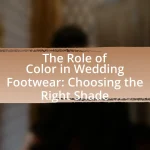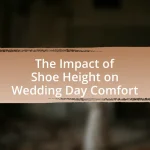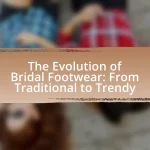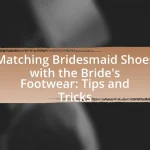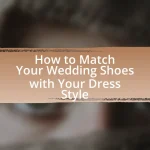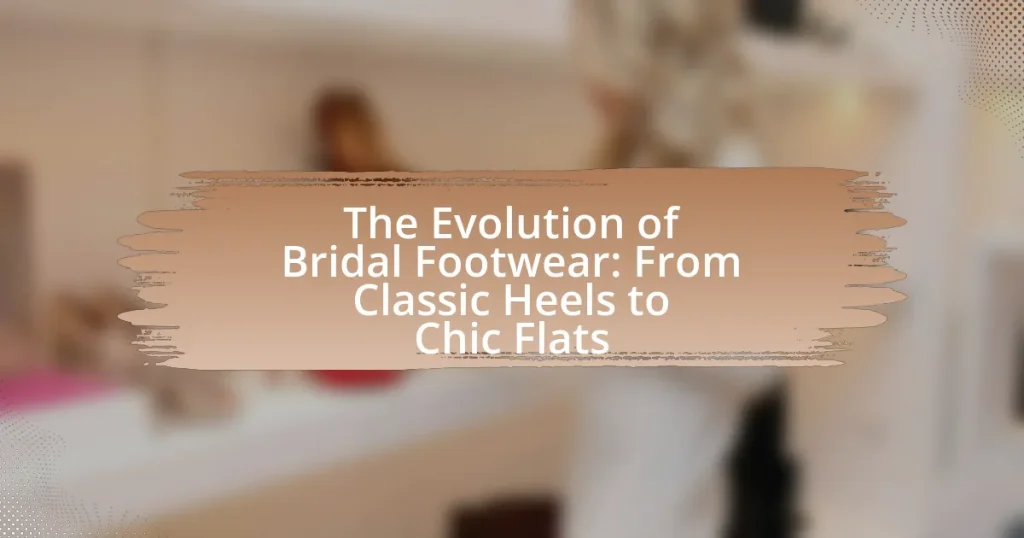The article examines the evolution of bridal footwear, highlighting the transition from traditional high heels to a diverse array of styles, including chic flats. It outlines how historical trends, societal changes, and cultural shifts have influenced bridal shoe designs over the decades, emphasizing the importance of comfort, style, and personalization in modern choices. Key trends such as sustainability, customization, and the growing popularity of flats are discussed, along with practical considerations for brides when selecting their footwear. The article also explores the impact of technology and emerging styles on the future of bridal footwear.
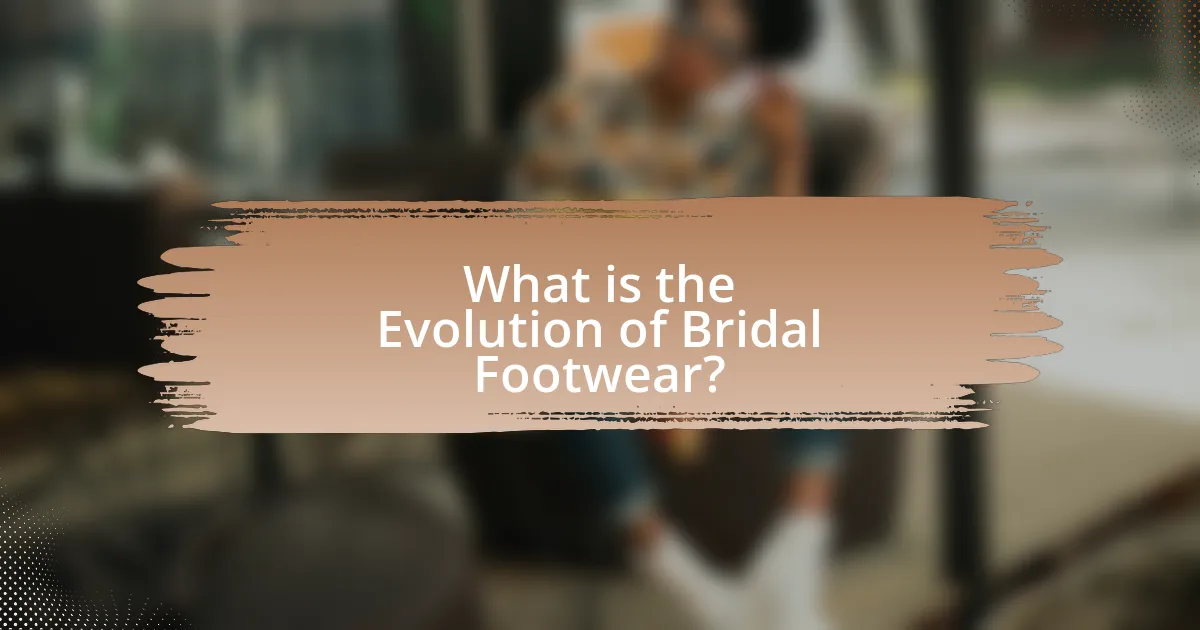
What is the Evolution of Bridal Footwear?
The evolution of bridal footwear has transitioned from traditional high heels to a diverse range of styles, including chic flats. Historically, bridal shoes were often ornate and designed to match the elaborate gowns of the time, with the Victorian era showcasing intricate designs and elevated heels. In the 20th century, the introduction of more practical styles reflected changing societal norms, leading to the popularity of lower heels and eventually flats, particularly in the late 20th and early 21st centuries. This shift aligns with a broader trend towards comfort and personal expression in wedding attire, as modern brides increasingly prioritize practicality without sacrificing style. The rise of casual weddings and outdoor ceremonies has further influenced this evolution, making flats a fashionable and functional choice for many brides today.
How has bridal footwear changed over the decades?
Bridal footwear has evolved significantly over the decades, transitioning from traditional high heels to more diverse styles, including chic flats. In the 1950s and 1960s, brides predominantly wore white satin pumps with pointed toes, reflecting the era’s formal fashion. By the 1970s and 1980s, platforms and block heels gained popularity, allowing for greater comfort and stability. The 1990s introduced a shift towards more casual styles, with brides opting for lower heels and even sandals. In the 2000s and beyond, the trend has embraced a wider variety of options, including ballet flats, sneakers, and custom designs, catering to individual preferences and comfort. This shift reflects broader societal changes towards personalization and practicality in wedding attire.
What were the most popular styles in the early 20th century?
The most popular styles in the early 20th century included Edwardian, Art Nouveau, and the early beginnings of Art Deco. The Edwardian style, characterized by high-waisted silhouettes and intricate lace details, dominated the early 1900s, while Art Nouveau introduced flowing lines and floral motifs. By the 1920s, Art Deco began to emerge, showcasing geometric shapes and bold colors. These styles influenced various aspects of fashion, including bridal footwear, where designs transitioned from ornate heels to more practical options as societal norms evolved.
How did cultural shifts influence bridal shoe designs?
Cultural shifts have significantly influenced bridal shoe designs by reflecting changing societal norms and values. For instance, the rise of feminism in the 1960s and 1970s led to a preference for more comfortable and practical footwear, resulting in the popularity of flats and lower heels for brides. Additionally, the increasing acceptance of diverse wedding styles and personal expression has encouraged designers to create a wider variety of styles, including bold colors and unconventional materials. This evolution is evidenced by the growing trend of brides opting for personalized shoes that align with their individual tastes rather than adhering to traditional white high heels, showcasing a shift towards individuality and comfort in bridal fashion.
Why is the choice of bridal footwear important?
The choice of bridal footwear is important because it impacts comfort, style, and the overall aesthetic of the wedding ensemble. Comfort is crucial as brides often spend long hours on their feet, and the right footwear can prevent discomfort and fatigue. Additionally, the style of the shoes must complement the wedding dress and theme, influencing the visual harmony of the bridal look. For instance, a study by the American Podiatric Medical Association highlights that improper footwear can lead to foot problems, emphasizing the need for thoughtful selection. Thus, the choice of bridal footwear is essential for both practical and aesthetic reasons.
How does footwear impact a bride’s overall look?
Footwear significantly impacts a bride’s overall look by influencing her silhouette, style, and comfort. The choice of shoes can enhance or detract from the wedding gown, as heels can create an elongated appearance, while flats may offer a more relaxed aesthetic. For instance, a study by the Fashion Institute of Technology highlights that the right footwear can complement the dress’s design and color, ensuring a cohesive look. Additionally, comfort plays a crucial role; brides who feel at ease in their shoes are more likely to exude confidence, which enhances their overall appearance on their special day.
What role does comfort play in selecting bridal shoes?
Comfort is a crucial factor in selecting bridal shoes, as it directly impacts the bride’s overall experience on her wedding day. A comfortable shoe allows the bride to enjoy the event without being hindered by pain or discomfort, which can detract from her enjoyment and confidence. Studies indicate that brides often spend long hours on their feet, making comfort essential to prevent fatigue and ensure mobility throughout the day. Additionally, the shift in bridal footwear trends towards chic flats and lower heels reflects a growing recognition of the importance of comfort alongside style, as many brides prioritize practicality without sacrificing aesthetics.
What are the key trends in modern bridal footwear?
Key trends in modern bridal footwear include a shift towards comfort, versatility, and personalization. Many brides are opting for chic flats and block heels instead of traditional stilettos, reflecting a desire for practicality without sacrificing style. Additionally, sustainable materials and ethical production practices are gaining popularity, as brides increasingly seek eco-friendly options. Customization, such as personalized embellishments or unique designs, allows brides to express their individuality. According to a survey by The Knot, 40% of brides now choose non-traditional footwear, indicating a significant change in preferences within the bridal market.
How have chic flats gained popularity among brides?
Chic flats have gained popularity among brides due to their comfort, practicality, and modern aesthetic. As weddings have evolved to prioritize personal style and guest experience, many brides are opting for flats to avoid discomfort during long ceremonies and receptions. The rise of casual and outdoor weddings has further contributed to this trend, as chic flats complement a variety of bridal styles while allowing for ease of movement. Additionally, fashion influencers and designers have embraced flats, showcasing them in bridal collections, which has reinforced their acceptance as a stylish alternative to traditional heels.
What materials are currently favored in bridal shoe design?
Currently, satin, lace, and leather are the most favored materials in bridal shoe design. Satin offers a luxurious sheen and is often used for its elegant appearance, while lace adds a delicate and romantic touch, aligning with traditional bridal aesthetics. Leather is favored for its durability and comfort, making it a practical choice for brides who prioritize wearability. These materials are chosen not only for their visual appeal but also for their ability to complement various bridal styles, from classic to modern.
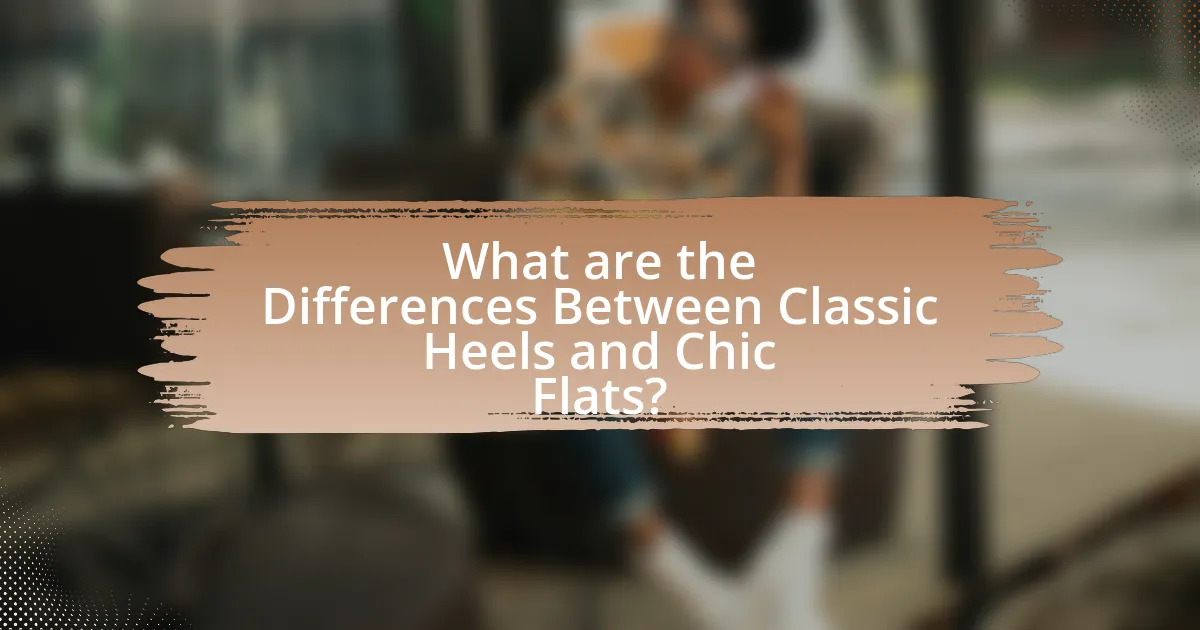
What are the Differences Between Classic Heels and Chic Flats?
Classic heels are characterized by their elevated design, typically featuring a pointed toe and a stiletto or block heel, while chic flats are designed without elevation, providing a more comfortable and casual option. The primary difference lies in their structure and intended use; classic heels are often associated with formal occasions and elegance, whereas chic flats prioritize comfort and versatility, making them suitable for a variety of settings. Additionally, classic heels can enhance posture and leg length, while chic flats offer ease of movement and practicality, appealing to modern brides seeking comfort on their wedding day.
What defines classic heels in bridal footwear?
Classic heels in bridal footwear are defined by their timeless design, typically featuring a stiletto or tapered heel that elevates the bride while maintaining elegance. These heels often incorporate materials such as satin or lace, and they may include embellishments like pearls or crystals, enhancing their traditional appeal. Historically, classic heels have been favored in weddings for their ability to complement formal gowns, with many brides opting for styles that reflect vintage aesthetics, as seen in bridal fashion trends from the 1950s and 1960s. This enduring popularity is supported by the fact that many bridal collections continue to showcase classic heel designs, affirming their status as a staple in bridal footwear.
What styles and designs are considered classic for bridal heels?
Classic styles and designs for bridal heels include the pointed-toe pump, the strappy sandal, and the classic peep-toe. These styles have remained popular due to their timeless elegance and versatility, making them suitable for various wedding themes. The pointed-toe pump, for instance, elongates the leg and adds sophistication, while strappy sandals offer a delicate and feminine touch. Peep-toe heels provide a playful yet refined look, often adorned with embellishments like lace or satin. Historical trends show that these designs have consistently been favored by brides for decades, reinforcing their status as classic choices in bridal footwear.
How do classic heels enhance the bridal silhouette?
Classic heels enhance the bridal silhouette by elevating the posture and elongating the legs, creating a more graceful and elongated appearance. This elevation not only accentuates the natural curves of the body but also complements the gown’s design, allowing for a more streamlined look. Studies in fashion design indicate that heels can add an average of 2 to 5 inches in height, which significantly alters the visual proportions of the wearer, making the overall silhouette appear taller and more elegant.
What are the advantages of choosing chic flats for weddings?
Choosing chic flats for weddings offers several advantages, primarily comfort and practicality. Flats allow brides to enjoy their special day without the discomfort often associated with high heels, enabling them to move freely and dance for extended periods. Additionally, chic flats come in a variety of stylish designs, ensuring that they can complement any wedding theme or dress. This versatility makes them a fashionable choice that does not sacrifice style for comfort. Furthermore, flats can be more affordable than traditional bridal heels, providing a cost-effective option for brides looking to manage their wedding budget effectively.
How do chic flats provide comfort without sacrificing style?
Chic flats provide comfort without sacrificing style by incorporating ergonomic designs and high-quality materials that prioritize foot health while maintaining aesthetic appeal. These flats often feature cushioned insoles, arch support, and flexible outsoles, which enhance comfort during prolonged wear. For instance, brands like Rothy’s utilize recycled materials and a seamless construction that molds to the foot, ensuring both a stylish look and a comfortable fit. This combination allows chic flats to serve as a fashionable alternative to traditional heels, appealing to modern brides who seek elegance without compromising on comfort.
What occasions are best suited for chic bridal flats?
Chic bridal flats are best suited for casual weddings, outdoor ceremonies, and destination weddings. These occasions often require comfort and practicality, allowing brides to move freely without the discomfort associated with high heels. For instance, outdoor settings like beaches or gardens can present uneven terrain, making flats a more sensible choice. Additionally, casual weddings typically emphasize a relaxed atmosphere, where chic flats can complement a less formal dress code while still maintaining elegance.
How do personal preferences influence the choice between heels and flats?
Personal preferences significantly influence the choice between heels and flats, as individuals prioritize comfort, style, and occasion suitability. For instance, many women prefer flats for their practicality and comfort during long events, while others may choose heels to enhance their stature and achieve a more formal look. Research indicates that 70% of women report comfort as a primary factor in their footwear choices, which directly impacts their decision between heels and flats. Additionally, cultural and social factors play a role; some may feel societal pressure to wear heels for weddings, while others embrace the trend of chic flats for a modern, comfortable alternative.
What factors should brides consider when making their choice?
Brides should consider comfort, style, venue, and budget when making their choice of footwear. Comfort is crucial as weddings often involve long hours of standing and dancing; choosing shoes that provide support can prevent discomfort. Style should align with the overall wedding theme and dress; for instance, classic heels may suit a formal gown, while chic flats may complement a more casual dress. The venue also influences the choice; outdoor weddings may require shoes that are suitable for grass or uneven surfaces. Lastly, budget considerations are essential, as bridal footwear can vary significantly in price, and brides should select options that fit within their overall wedding budget.
How can a bride’s wedding theme affect her footwear selection?
A bride’s wedding theme significantly influences her footwear selection by dictating the style, color, and formality of the shoes. For instance, a rustic or bohemian theme may lead a bride to choose comfortable flats or sandals, while a formal or traditional theme might necessitate elegant heels. The choice of footwear aligns with the overall aesthetic and ambiance of the wedding, ensuring cohesion between the dress and the setting. Additionally, specific themes often come with color palettes that can guide the selection of shoe colors and materials, reinforcing the visual narrative of the event.
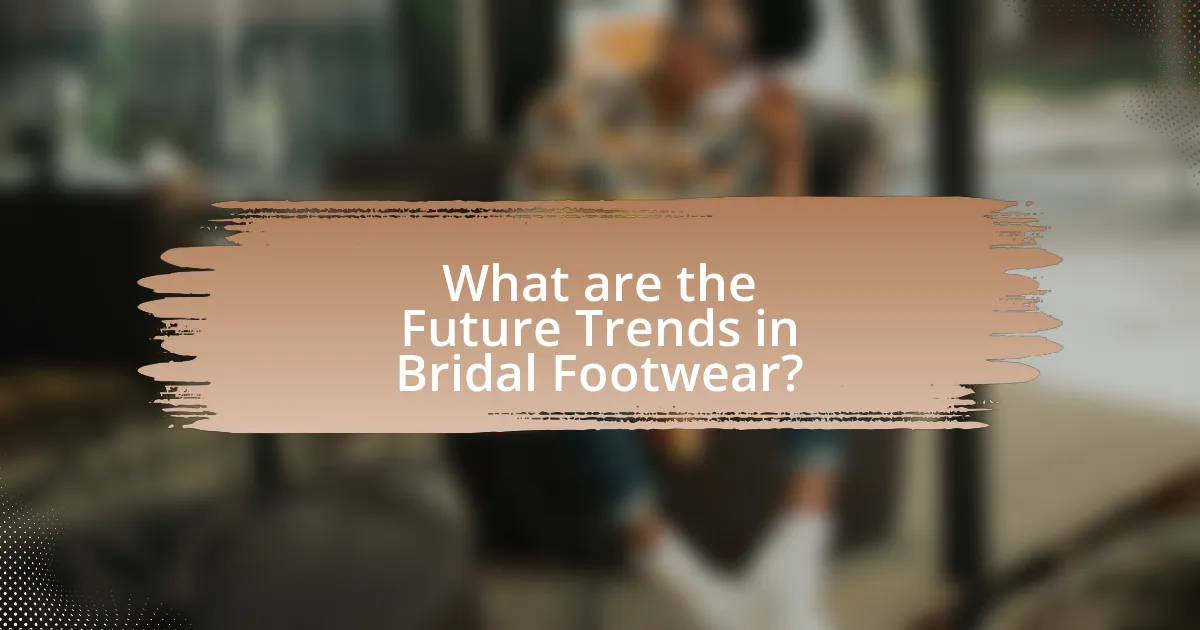
What are the Future Trends in Bridal Footwear?
Future trends in bridal footwear include a shift towards comfort, sustainability, and personalization. As brides increasingly prioritize comfort, styles such as chic flats and block heels are gaining popularity, allowing for ease of movement throughout the wedding day. Sustainability is also becoming a key focus, with many designers opting for eco-friendly materials and ethical production practices, reflecting a growing consumer demand for environmentally conscious choices. Additionally, personalization trends are emerging, where brides seek unique designs that reflect their individual style, often incorporating custom elements or bespoke features. This evolution aligns with broader fashion trends emphasizing practicality and individuality in bridal attire.
How are sustainability and eco-friendliness shaping bridal shoe choices?
Sustainability and eco-friendliness are significantly influencing bridal shoe choices by driving demand for ethically produced and environmentally friendly materials. Many brides are now prioritizing shoes made from sustainable resources, such as organic cotton, recycled materials, and vegan leather, reflecting a broader trend towards conscious consumerism in the wedding industry. According to a survey by The Knot, 60% of couples are willing to pay more for sustainable wedding products, indicating a shift in purchasing behavior that favors eco-friendly options. This trend not only promotes environmental responsibility but also encourages designers to innovate in creating stylish yet sustainable footwear, aligning with the evolving values of modern brides.
What materials are being used to create sustainable bridal footwear?
Sustainable bridal footwear is primarily made from eco-friendly materials such as organic cotton, recycled polyester, and natural rubber. Organic cotton is cultivated without harmful pesticides, reducing environmental impact, while recycled polyester repurposes plastic waste, minimizing landfill contributions. Natural rubber, sourced from rubber trees, is biodegradable and renewable, making it a sustainable alternative to synthetic materials. These materials not only support environmental sustainability but also cater to the growing demand for ethical fashion in the bridal industry.
How can brides find eco-friendly options for their wedding shoes?
Brides can find eco-friendly options for their wedding shoes by researching brands that prioritize sustainable materials and ethical manufacturing practices. Many companies now offer shoes made from recycled materials, organic fabrics, or vegan leather, which significantly reduce environmental impact. Additionally, brides can explore second-hand or vintage shops, where pre-owned shoes contribute to sustainability by minimizing waste. Online platforms dedicated to eco-conscious fashion also provide curated selections of sustainable bridal footwear, making it easier for brides to make informed choices.
What innovations are emerging in bridal footwear design?
Innovations in bridal footwear design include the use of sustainable materials, customizable options, and advanced comfort technologies. Sustainable materials, such as vegan leather and recycled fabrics, are increasingly popular as brides seek eco-friendly choices. Customizable options allow brides to personalize their footwear with unique colors, embellishments, and styles, catering to individual tastes. Additionally, advanced comfort technologies, such as cushioned insoles and ergonomic designs, enhance wearability, addressing the need for comfort during long wedding days. These trends reflect a shift towards practicality and personalization in bridal footwear.
How is technology influencing the creation of bridal shoes?
Technology is significantly influencing the creation of bridal shoes by enabling advanced design techniques and materials. Innovations such as 3D printing allow for custom-fit designs that enhance comfort and style, while digital design software facilitates intricate detailing and personalization options. Additionally, the use of sustainable materials, driven by technological advancements, is becoming more prevalent, aligning with eco-conscious consumer preferences. For instance, brands are now utilizing biodegradable materials and recycled fabrics, reflecting a shift towards sustainability in bridal footwear.
What new styles are predicted to become popular in the coming years?
Chic flats and platform sneakers are predicted to become popular in bridal footwear in the coming years. This shift is driven by a growing preference for comfort and practicality among brides, as evidenced by recent trends in wedding fashion that prioritize ease of movement without sacrificing style. Additionally, the rise of outdoor and destination weddings has further fueled the demand for versatile and comfortable footwear options, making chic flats and platform sneakers ideal choices for modern brides.
What practical tips should brides consider when selecting their footwear?
Brides should prioritize comfort, style, and practicality when selecting their footwear. Choosing shoes that fit well and provide adequate support is essential, as weddings often involve long hours of standing and dancing. Additionally, brides should consider the venue and terrain; for outdoor weddings, flat or block-heeled shoes may be more suitable to prevent sinking into grass or sand. It’s also advisable to break in new shoes before the wedding day to avoid blisters. Finally, coordinating the footwear with the wedding dress style enhances the overall look, ensuring that the shoes complement rather than clash with the bridal attire.
How can brides ensure their shoes are comfortable for the entire day?
Brides can ensure their shoes are comfortable for the entire day by selecting styles with adequate support, cushioning, and a proper fit. Choosing shoes made from breathable materials and those with a lower heel height can significantly reduce discomfort. Additionally, breaking in the shoes before the wedding day allows for adjustments to be made, ensuring a better fit. Research indicates that shoes with arch support and shock-absorbing soles can alleviate pressure on the feet, enhancing comfort during prolonged wear.
What are the best practices for breaking in new bridal shoes?
To break in new bridal shoes effectively, wear them around the house for short periods to gradually soften the material and mold them to your feet. This practice allows the shoes to adjust to your foot shape, reducing discomfort on your wedding day. Additionally, using thick socks while wearing the shoes can help stretch them slightly, providing a more comfortable fit. According to footwear experts, breaking in shoes this way can prevent blisters and soreness, ensuring that the shoes are comfortable for extended wear.

